Principles of Therapeutic Exercise
1/102
There's no tags or description
Looks like no tags are added yet.
Name | Mastery | Learn | Test | Matching | Spaced |
|---|
No study sessions yet.
103 Terms
what are 2 TYPES of MUSCLE CONTRACTIONS
1. isometric
2. isotonic
what are 2 TYPES of ISOTONIC MUSCLE CONTRACTIONS
1. concentric
2. eccentric
with an ISOMETRIC MUSCLE CONTRACTION, do the muscles produce force WITH/WITHOUT SIGNIFICANT CHNAGE in LENGTH
WITHOUT significant change in length
when does an ISOMETRIC MUSCLE CONTRACTION typically occur
when joint is CONSTRAINED
what are 2 EXAMPLES of ISOMETRIC MUSCLE CONTRACTION
1. wall sit
2. plank
what should be considered with an ISOMETRIC MUSCLE CONTRACTION
length tension curve
regarding the LENGTH TENSION CURVE, when does ACTIVE INSUFFICIENCY occur
muscle is too shortened to generate max force
regarding the LENGTH TENSION CURVE, when does PASSIVE INSUFFICIENCY occur
muscle is too ELONGATED to generate max force
with a CONCENTRIC MUSCLE CONTRACTION, do the muscles produce force while it SHORTENS/LENGTHENS in LENGTH
SHORTENS in length
what MOVEMENTS are considered CONCENTRIC
many of the standard movements
what are 2 EXAMPLES of CONCENTRIC MUSCLE CONTRACTIONS
1. lifting something to head height
2. rising from seated position
what is CONTRACTION VELOCITY based on with CONCENTRIC MUSCLE CONTRACTIONS
load
with CONCENTRIC MUSCLE CONTRACTIONS, what do LIGHT LOADS result in
faster contraction velocity
what CURVE should be considered with CONCENTRIC MUSCLE CONTRACTIONS
length tension curve
with a ECCENTRIC MUSCLE CONTRACTION, do the muscles produce force while it INCREASING/DECREASING in LENGTH
INCREASING in length
what are 3 EXAMPLES of ECCENTRIC MUSCLE CONTRACTION
1. deceleration
2. walking downhill
3. descending stairs
what is CONTRACTION VELOCITY based on with ECCENTRIC MUSCLE CONTRACTIONS
load
with ECCENTRIC MUSCLE CONTRACTIONS, what do HEAVIER LOADS result in
faster movement
what CURVE should be considered with ECCENTRIC MUSCLE CONTRACTIONS
length tension curve
what do LEVER BASICS covert
force into a torque
what is the FORMULA for TORQUE
torque = force x distance
what is the LEVER BASICS between shoulder abduction + overhead press
SHOULDER ABDUCTION:
- higher torque
- longer distance = harder
OVERHEAD PRESS
- lower torque
- shorter distance = easier
what are the 3 LEVER CLASSES
1. 1st class
2. 2nd class
3. 3rd class
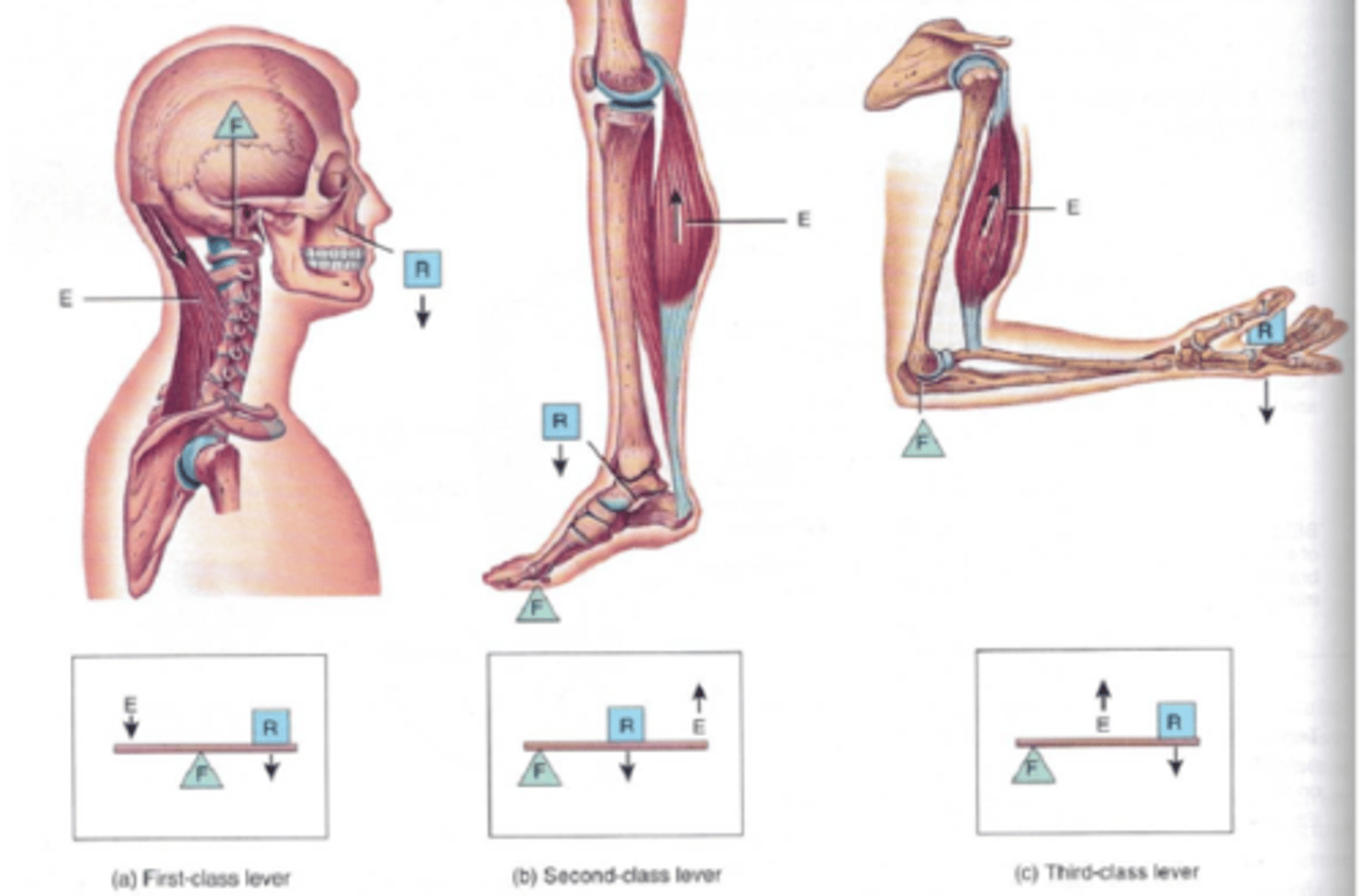
what is a FIRST CLASS LEVER
axis of rotation is BETWEEN INTERNAL + EXTERNAL FORCES
- internal force = external force
- fulcrum between muscle force (internal force) + gravity (external force)
ex: seesaw
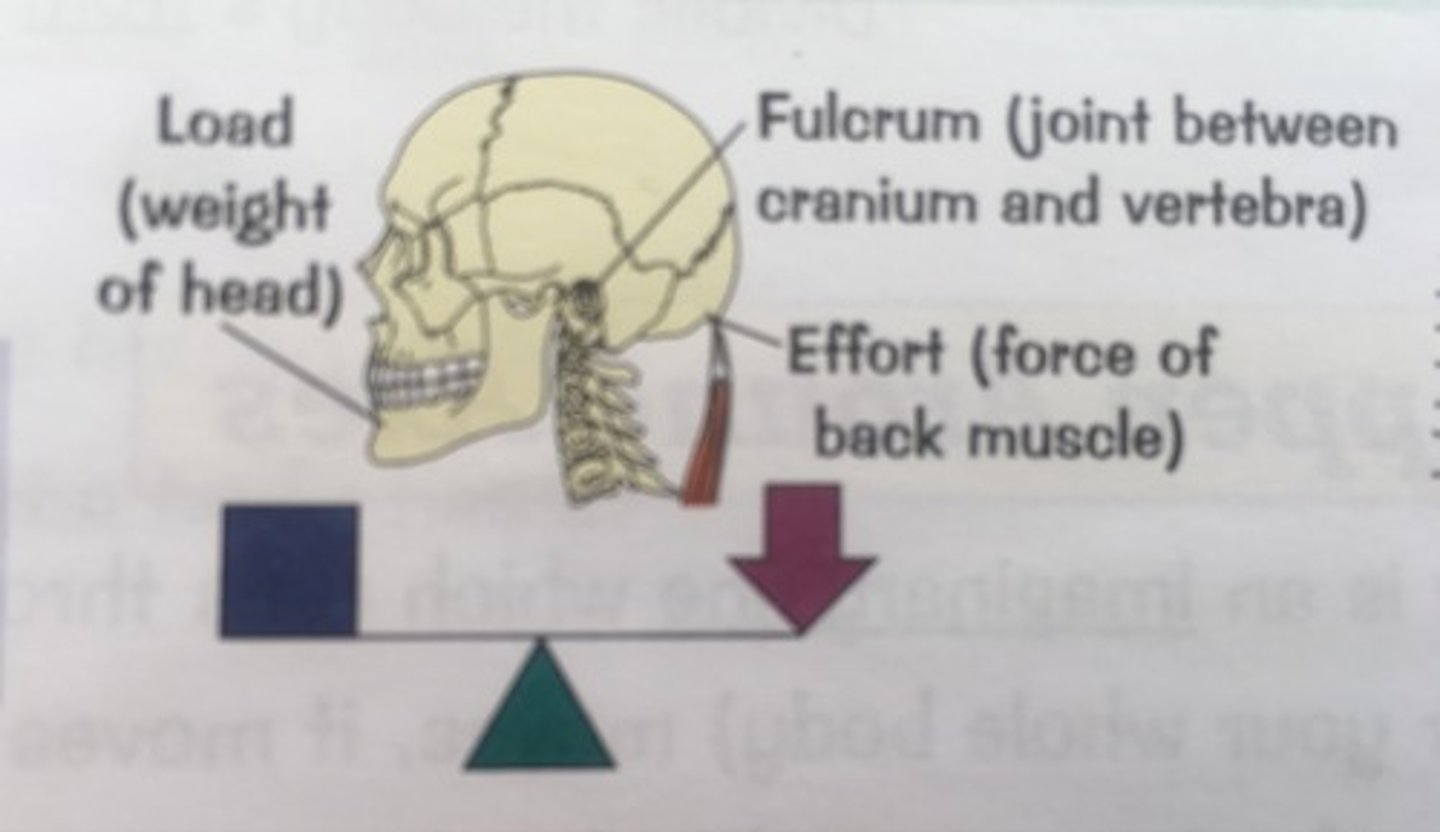
where is the AXIS of ROTATION located with a FIRST CLASS LEVER
between internal + external forces
what is an EXAMPLE of a FIRST CLASS LEVER
head on occiput
- AO joint (fulcrum) between neck extensors (internal force) + gravity on skull (external force)
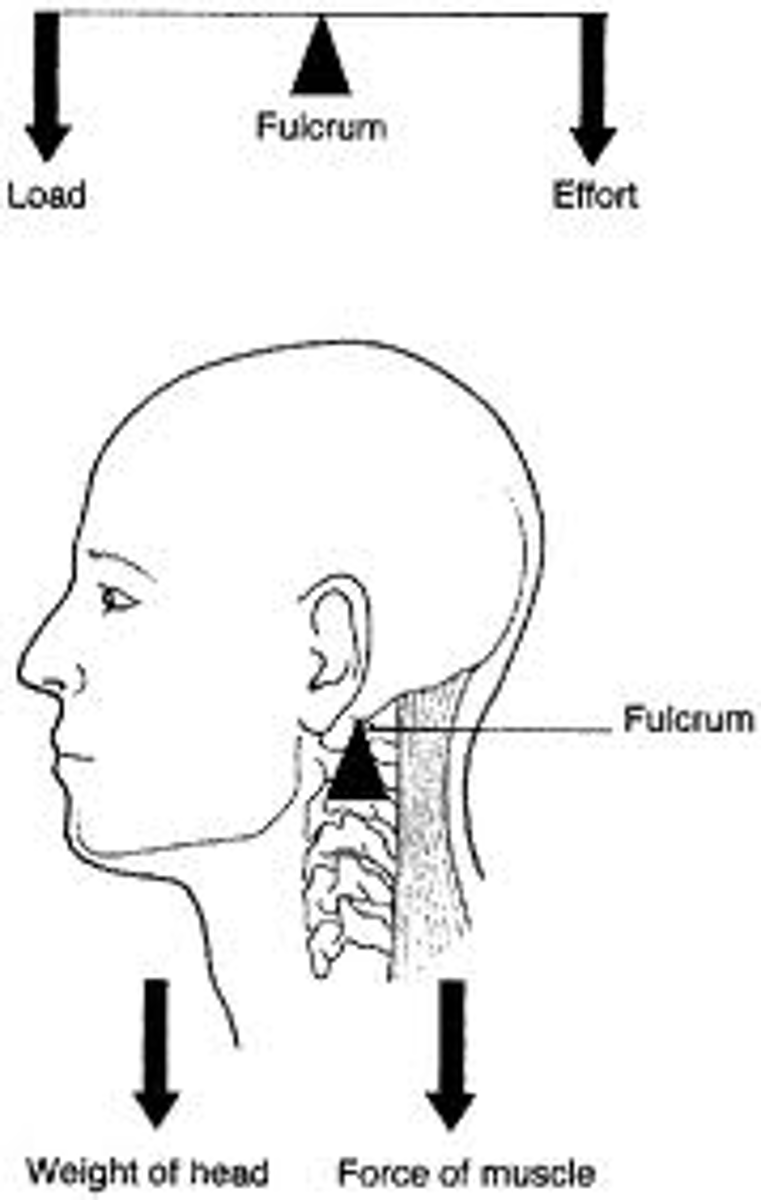
what is a SECOND CLASS LEVER
axis of rotation is located at END of ONE BONE
- internal force is at greater leverage than external force (internal force > external force)
- muscles attaches FURTHER from axis of rotation than the external force
ex: wheelbarrow
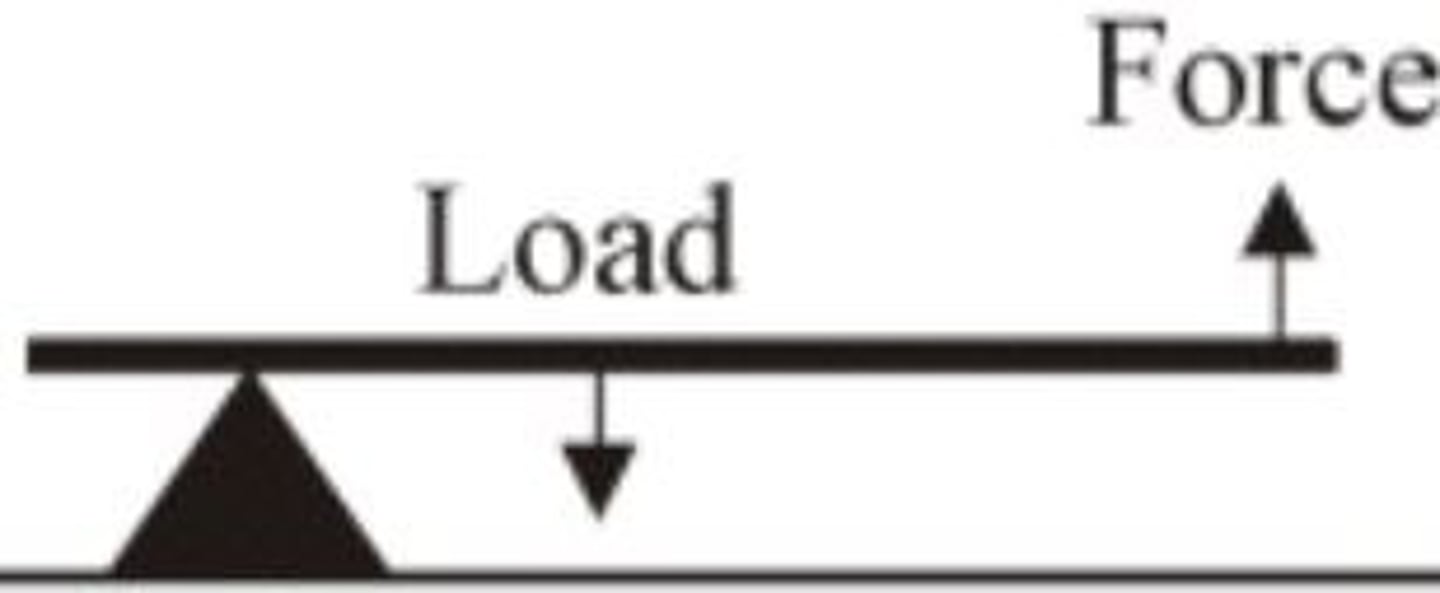
where is the AXIS of ROTATION located with SECOND CLASS LEVERS
at the end of one bone
with SECOND CLASS LEVERS, is the INTERNAL FORCE at GREATER/LESSER LEVERAGE than EXTERNAL FORCE
internal force GREATER LEVERAGE than external force
with SECOND CLASS LEVERS, does the MUSCLE attach FURTHER/CLOSER from axis of rotation than external force
muscle attaches FURTHER from axis of rotation
what is an EXAMPLE of a SECOND CLASS LEVER
plantarflexion
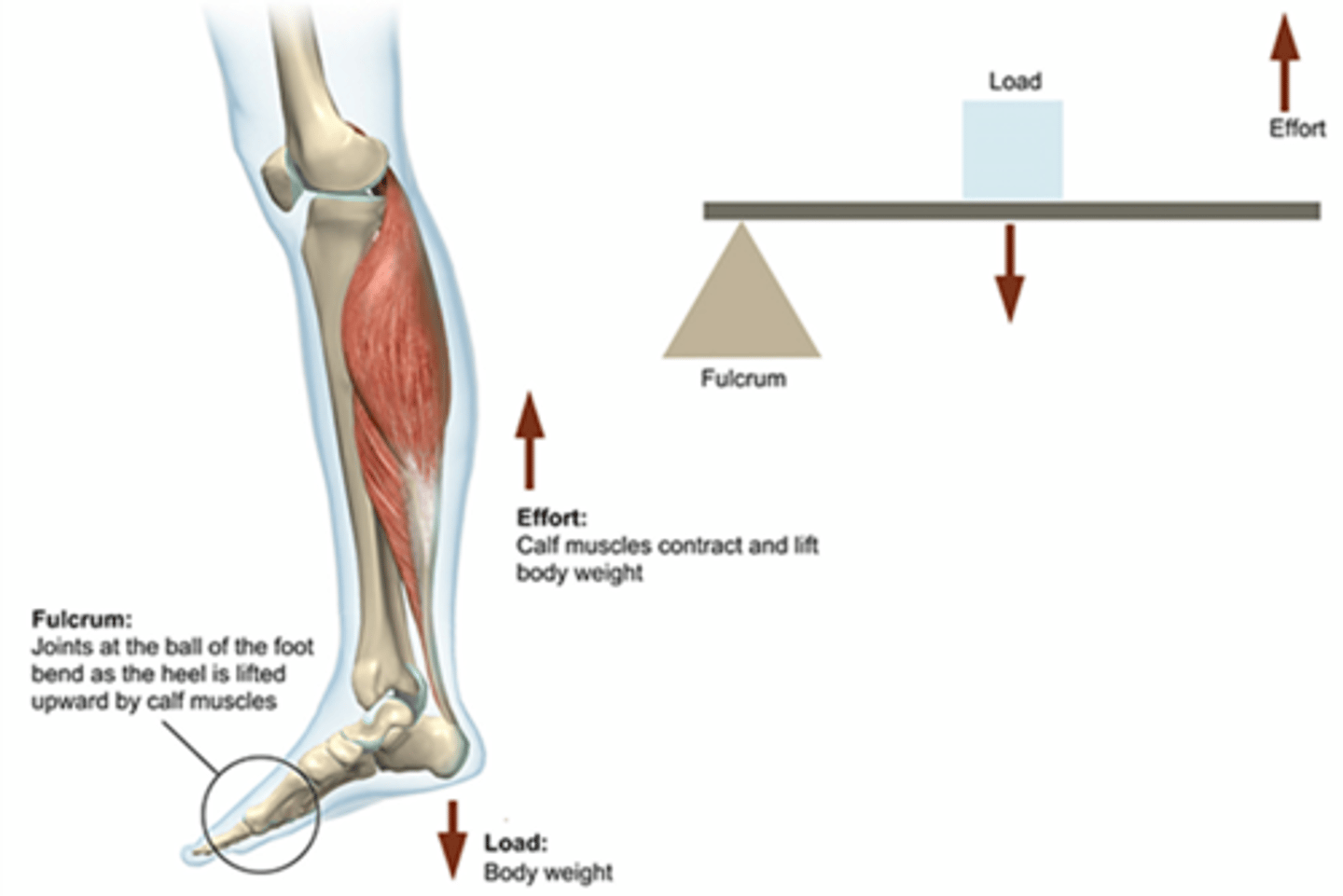
what is a THIRD CLASS LEVER
axis of rotation is located at the END of ONE BONE
- external force is at greater leverage than the internal force
- muscle attaches CLOSER to the axis of rotation than the external force
ex: bicep curl
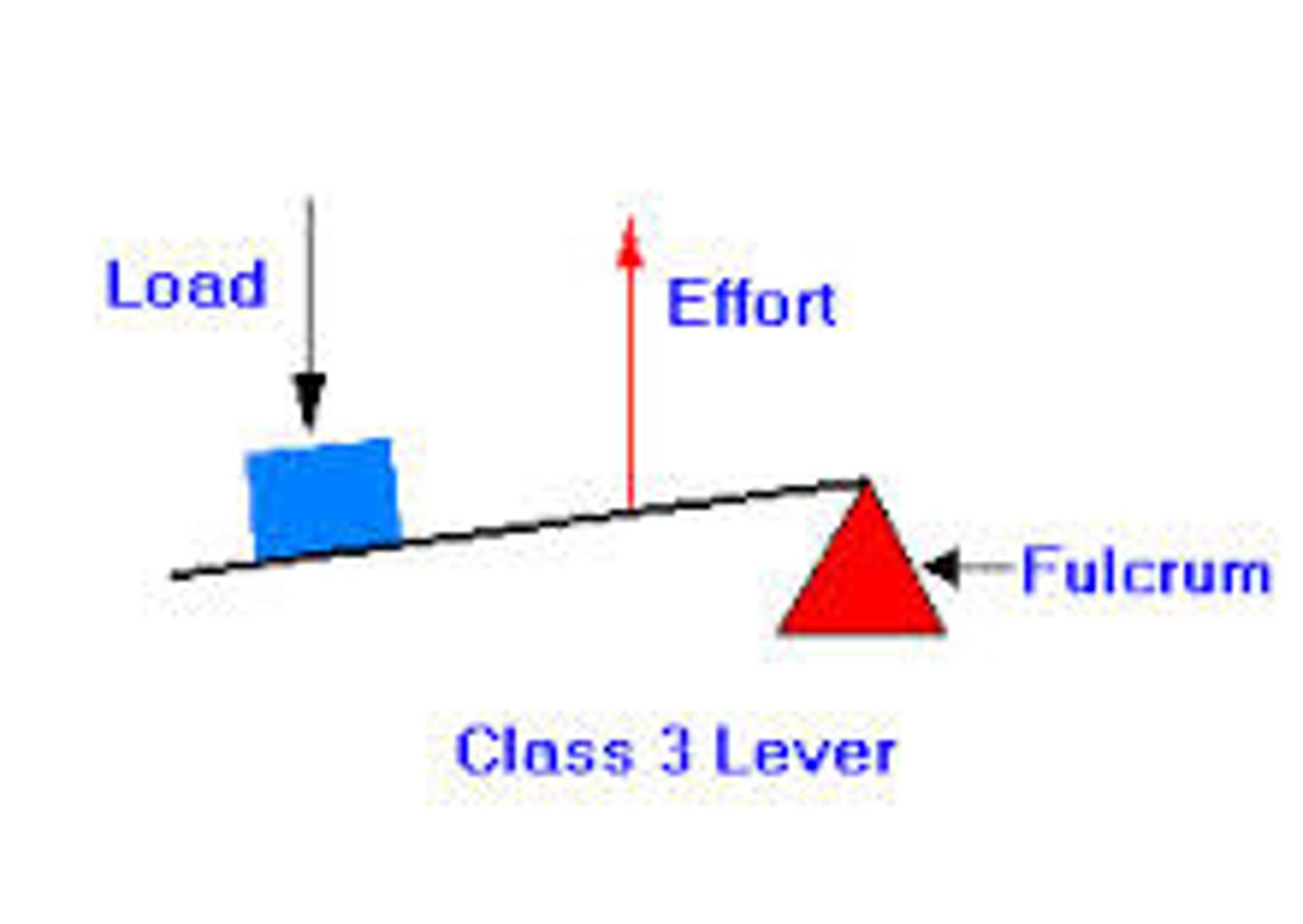
where is the AXIS of ROTATION located with THIRD CLASS LEVERS
at the end of one bone
with THIRD CLASS LEVERS, is the EXTERNAL FORCE at GREATER/LESSER LEVERAGE than INTERNAL FORCE
external force GREATER LEVERAGE than internal force
with THIRD CLASS LEVERS, does the MUSCLE attach FURTHER/CLOSER to axis of rotation than external force
muscle attaches CLOSER to axis of rotation
what is an EXAMPLE of a THIRD CLASS LEVER
elbow flexors (bicep curls)
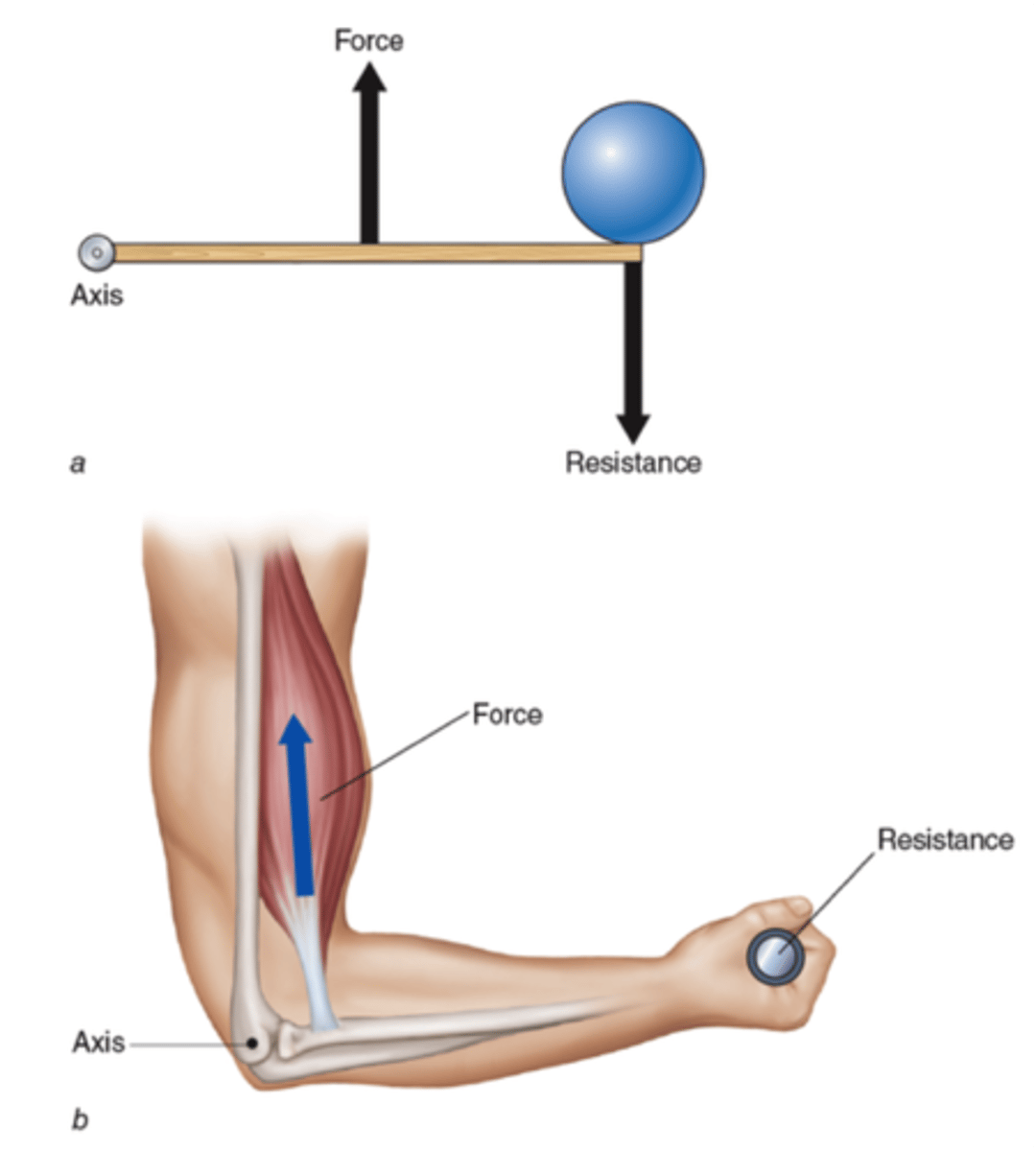
what are 2 TYPES of KINETIC CHAINS
1. open kinetic chain
2. closed kinetic chain
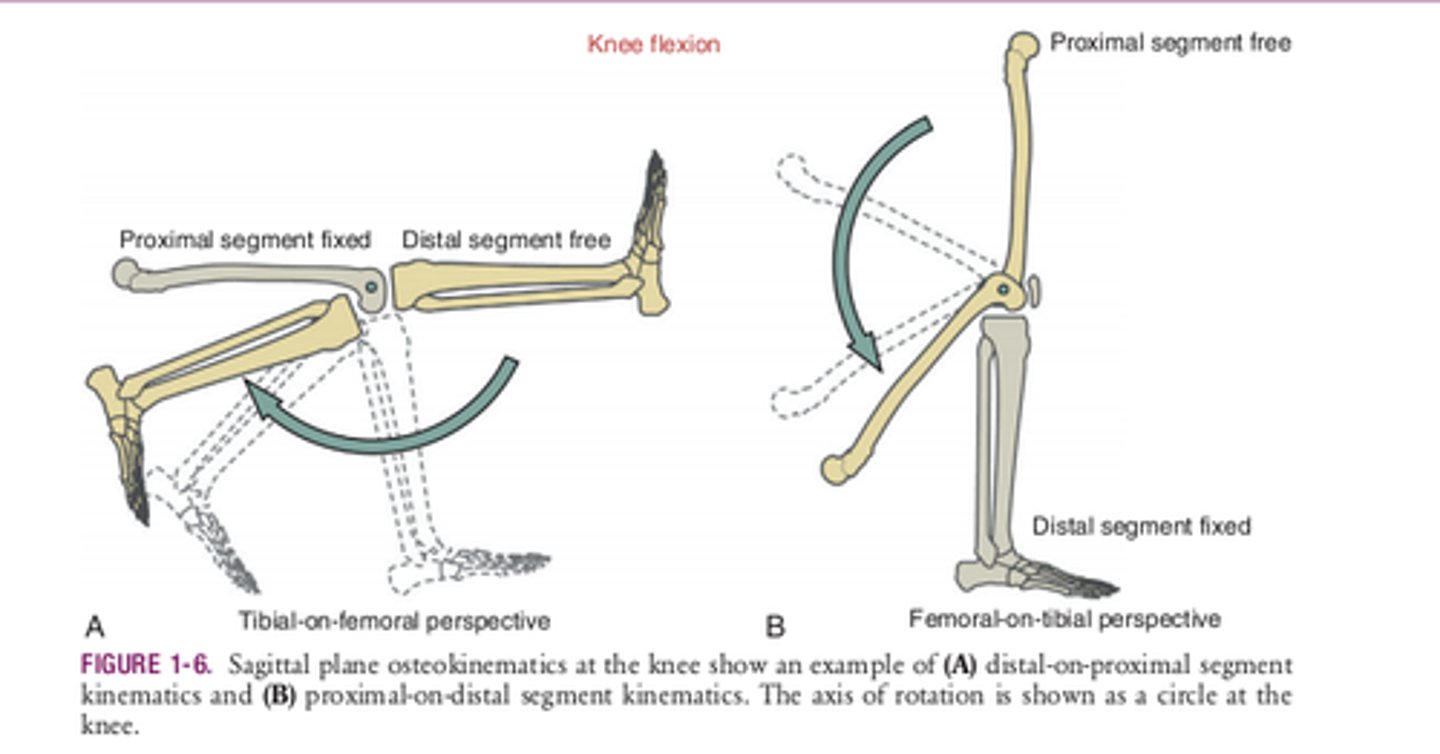
what are 2 CHARACTERISTICS of OPEN KINETIC CHAIN EXERCISES
1. DISTAL SEGMENT moving
2. PROXIMAL SEGMENT remains relative still (proximal segment fixed)
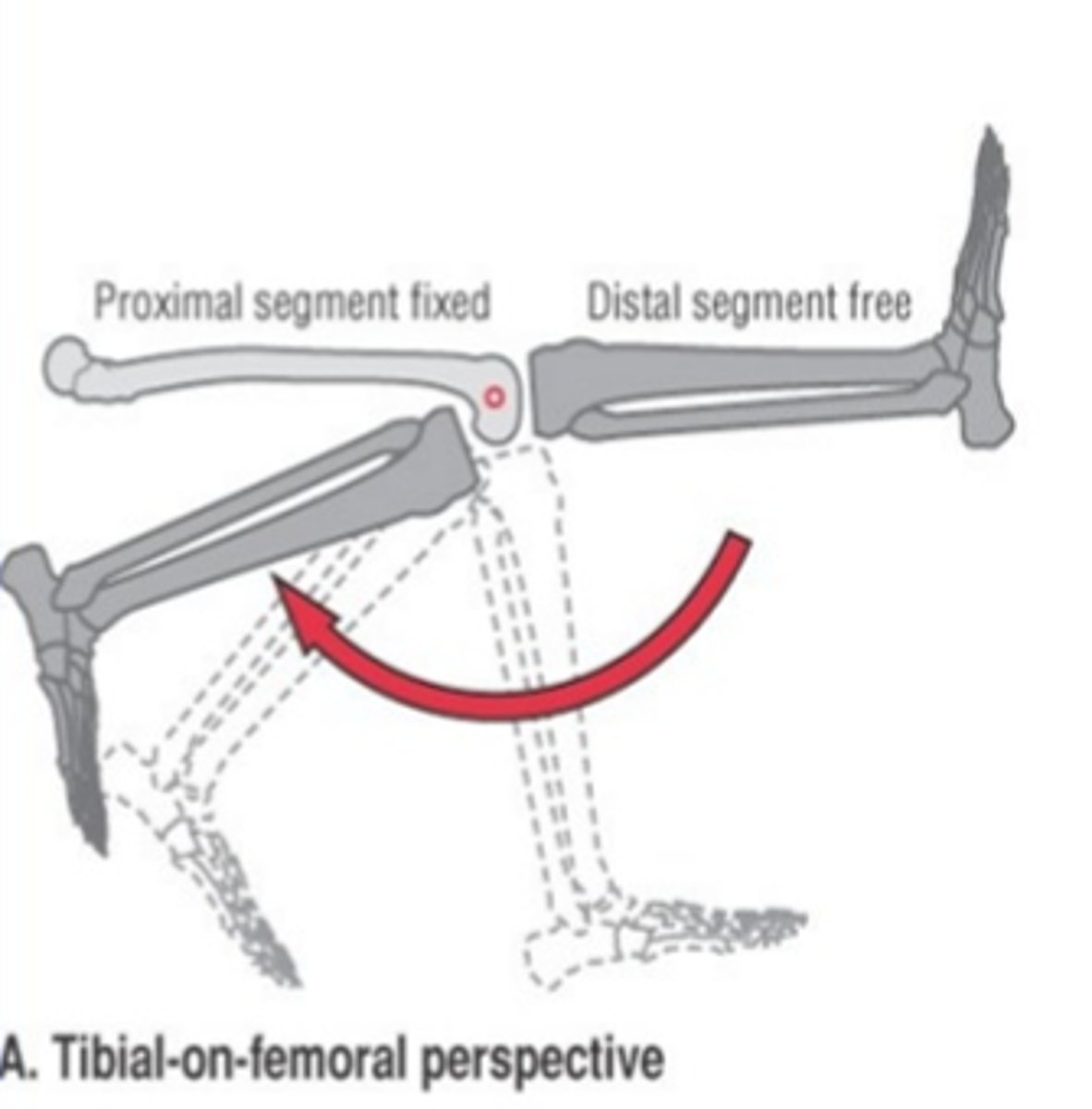
with OPEN KINETIC CHAIN EXERCISES, is the DISTAL SEGMENT moving/fixed
distal segment MOVING
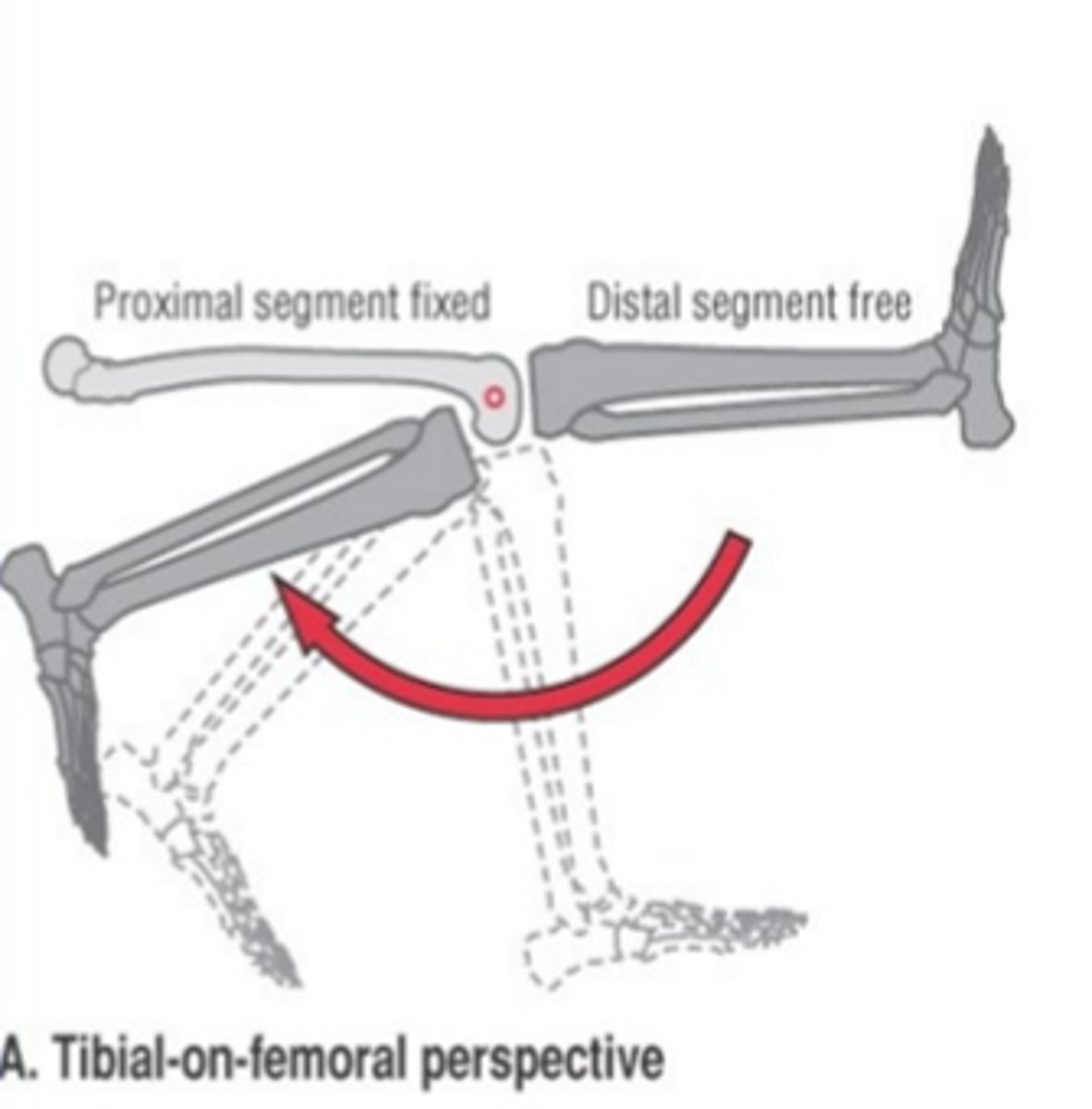
with OPEN KINETIC CHAIN EXERCISES, is the PROXIMAL SEGMENT moving/fixed
proximal segment FIXED
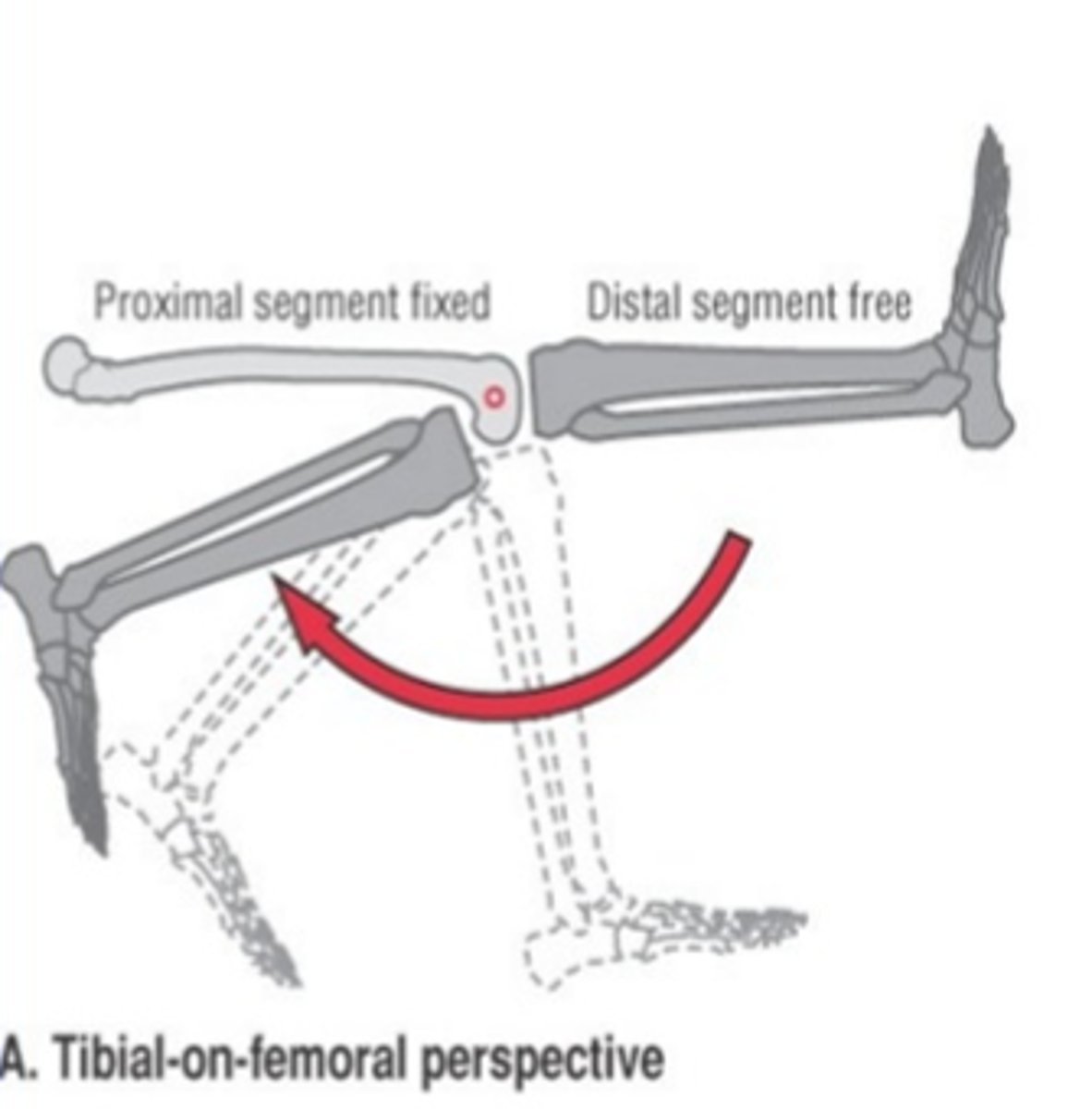
what are 2 CHARACTERISTICS of CLOSED KINETIC CHAIN EXERCISES
1. PROXIMAL SEGMENT moving
2. DISTAL SEGMENT remains relative still (distal segment fixed)
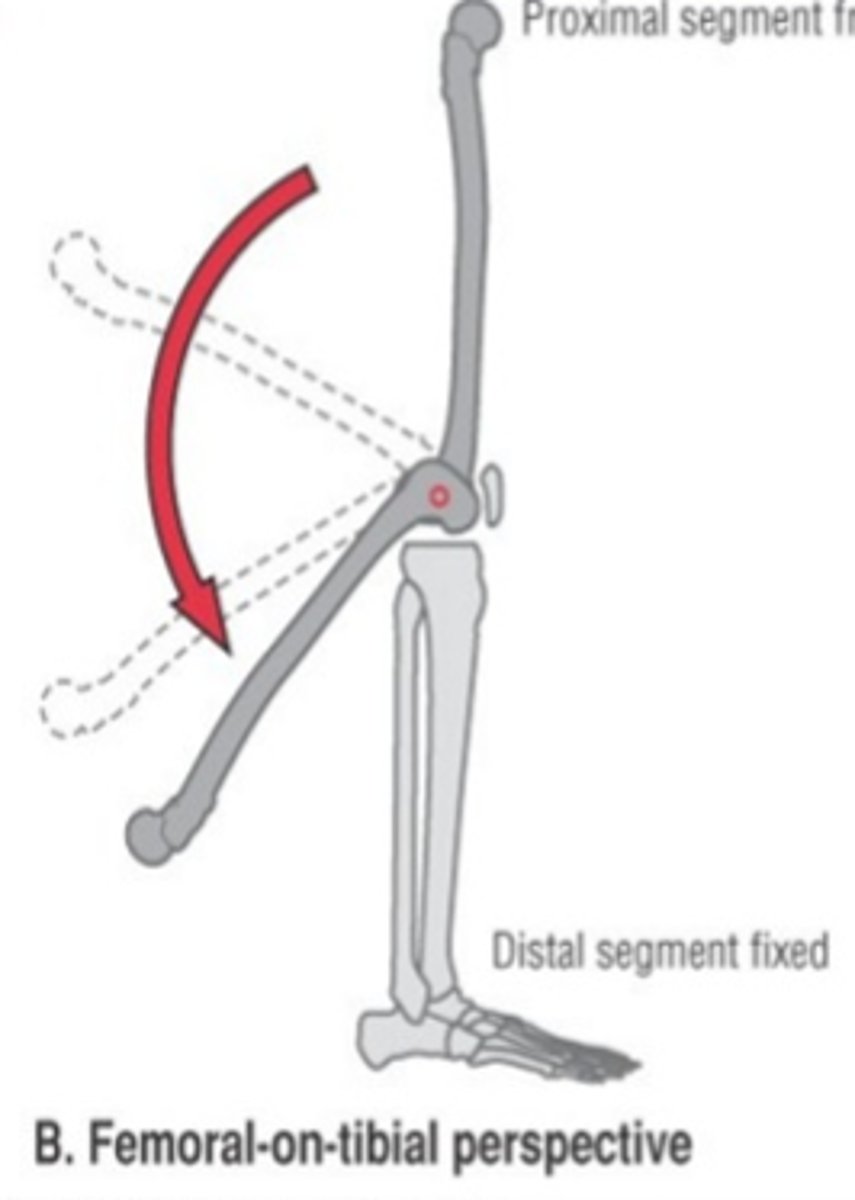
with CLOSED KINETIC CHAIN EXERCISES, is the DISTAL SEGMENT moving/fixed
distal segment FIXED
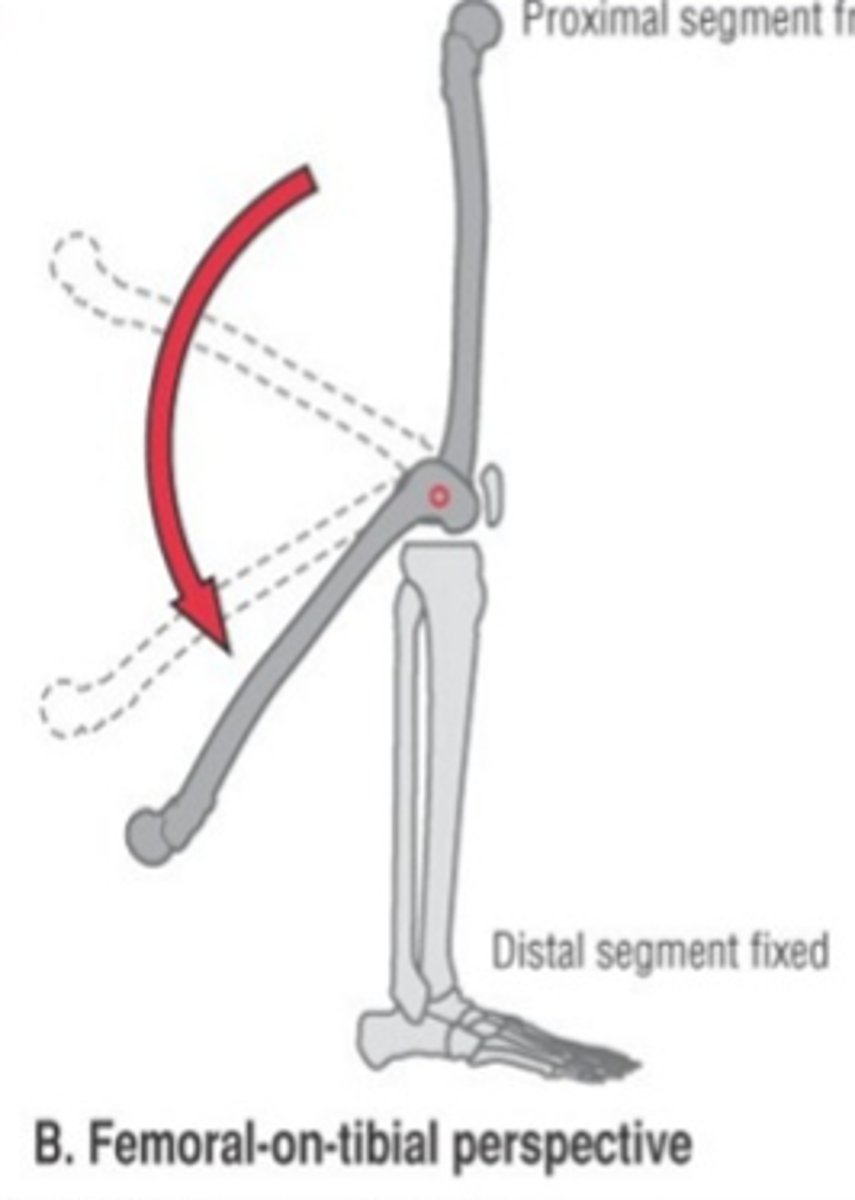
with CLOSED KINETIC CHAIN EXERCISES, is the PROXIMAL SEGMENT moving/fixed
proximal segment MOVING
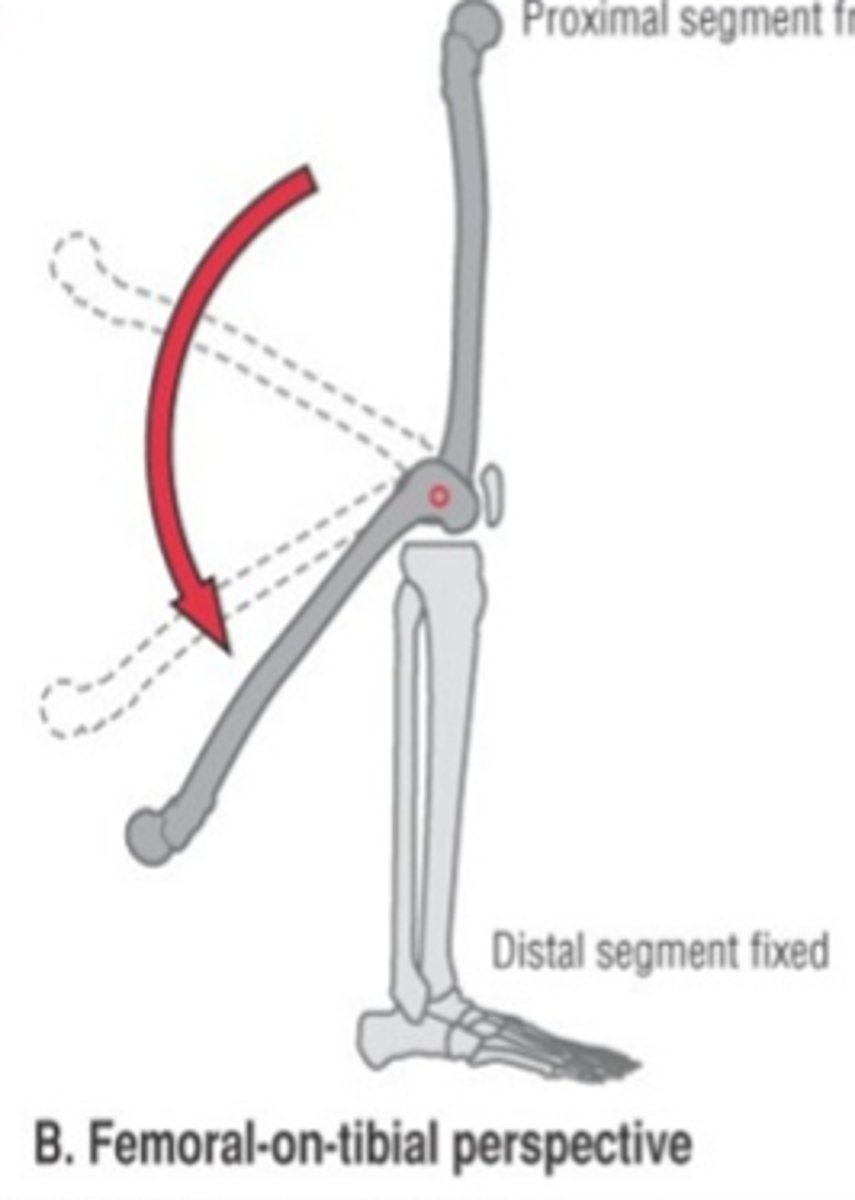
what are 2 EXAMPLES of OPEN KINETIC CHAIN EXERCISES
1. scaption
2. leg extension
what are 3 EXAMPLES of CLOSED KINETIC CHAIN EXERCISES
1. squat
2. step up
3. push up
what is the difference between OPEN KINETIC CHAIN + CLOSED KINETIC CHAIN
OPEN KINETIC CHAIN
1. no movement in adjacent joints
2. movement is only distal to joints
3. predominantly only primary mover muscle group activated
CLOSED KINETIC CHAIN
1. predictable movement in adjacent joints
2. can get movement throughout body
3. multiple muscle groups activated
with OPEN KINETIC CHAIN, is there MOVEMENT/NO MOVEMENT in adjacent joints
NO MOVEMENT in adjacent joints
with OPEN KINETIC CHAIN, where is MOVEMENT located
only distal to joint
with OPEN KINETIC CHAIN, what MUSCLE GROUP is only predominantly activated
primary mover muscle group
with CLOSED KINETIC CHAIN, is the movement PREDICTABLE/NOT PREDICTABLE in adjacent joints
PREDICTABLE MOVEMENT in adjacent joints
with CLOSED KINETIC CHAIN, where is MOVEMENT
throughout body
with CLOSED KINETIC CHAIN, what MUSCLE GROUP is activated
multiple muscle groups
what are 5 CONSIDERATIONS when PRESCRIBING ACTIVITIES
1. time under tension
2. heart rate response
3. rate of perceived exertion
4. percentage of 1 rep max
5. reps in reserve
what are 2 COMPONENTS of TIME UNDER TENSION
1. flexibility/ROM
2. strength
what is FLEXIBILITY/ROM described as regarding TIME UNDER TENSION
how long is the soft tissue in an elongated state
what is STRENGTH described as regarding TIME UNDER TENSION
how long is the contractile tissue working against an external load
what is HEART RATE RESPONSE traditionally considered
endurance
what is the FORMULA for calculating AGE PREDICTED MAXIMUM HEART RATE
207-(0.7 x age)
regarding HEART RATE RESPONSE, what TYPE of ACTIVITIES should be PRESCRIBED
activities to achieve a percentage of maximum heart rate
what is the RATE of PERCEIVED EXERTION SCALE
is a subjective assessment of intensity of activity
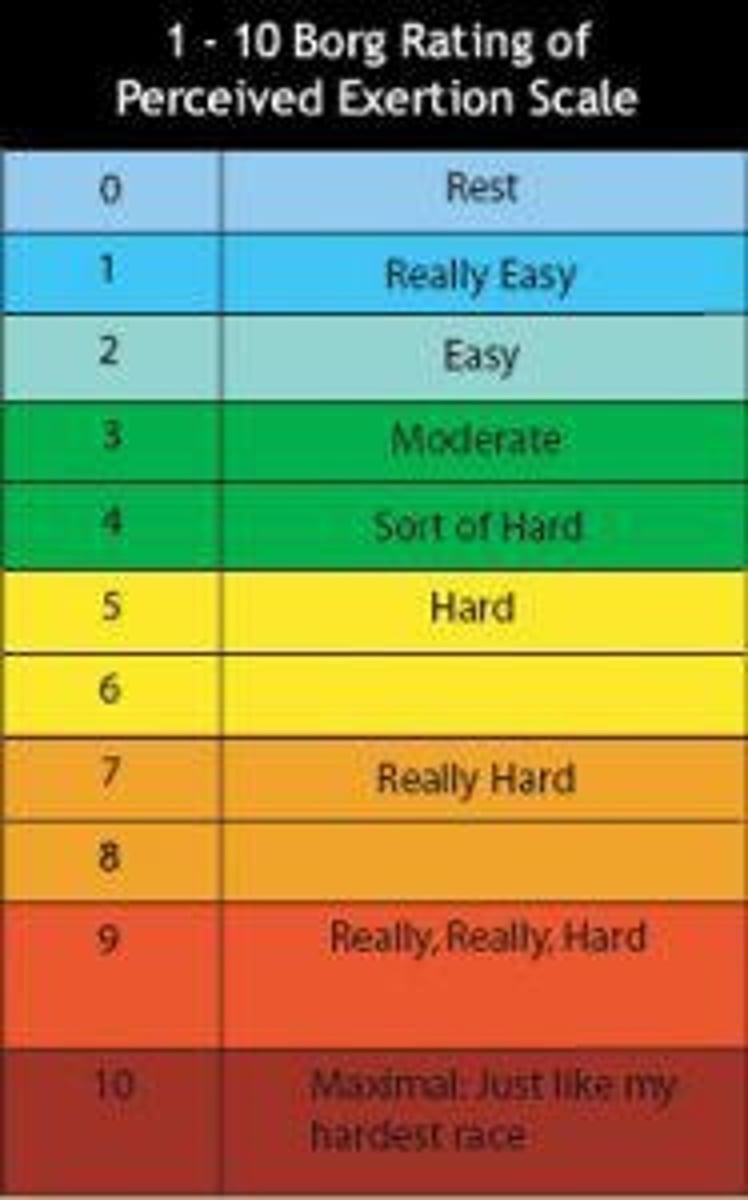
what are 3 DIFFERENT WAYS to monitor RPE for different activities
1. endurance
2. strength
3. overall session
what is PERCENTAGE of 1 REP MAX used for
strength training
what does PERCENTAGE of 1 REP MAX rely on
maximum strength testing
what is REPS in RESERVE used for
strength training
what is required when utilizing REPS in RESERVE during exercise
discussion with patient throughout session
what are 3 TRAINING PRINCIPLES
1. progressive overload
2. SAID
3. transfer of training
what does PROGRESSIVE OVERLOAD state
tissues responds to demands placed on it
regarding PROGRESSIVE OVERLOAD, what does MINIMAL EFFECTIVE DOSE (THRESHOLD) state
there is a minimum intensity required to achieve physiologic change
what is the MUSCLE response to PROGRESSIVE OVERLOAD TRAINING
muscle get STRONGER/LONGER
what is the TENDON response to PROGRESSIVE OVERLOAD TRAINING
tendon gets STRONGER/MORE ELASTIC
what is the LIGAMENT response to PROGRESSIVE OVERLOAD TRAINING
ligament gets STRONGER/MORE ELASTIC
what is the BONE response to PROGRESSIVE OVERLOAD TRAINING
bone gets MORE DENSE
what is the CARDIOVASCULAR SYSTEM response to PROGRESSIVE OVERLOAD TRAINING
CV system becomes MORE EFFICIENT
what 2 TRAINING PRINCIPLES work together
1. SAID
2. transfer of training
what does the SAID TRAINING PRINCIPLE state
improvements are highly specific to training approach
1. specific adaptation to imposed demands
what LAW is the SAID training principle an extension of
Wolff's Law
what does TRANSFER of TRAINING suggest
that there's CARRY OVER between tasks
what type of training is the TRANSFER of TRAINING PRINCIPLE used for
cross training
what are 3 TYPES of PERIODIZATION
1. linear
2. block
3. undulated
what is LINEAR PERIODIZATION
is a straight line approach to progressively increasing load
what is the LINEAR PERIODIZATION for TRADITIONAL STRENGTH + CONDITIONING
endurance/hypertrophy > strength > power
what is the LINEAR PERIODIZATION for TRADITIONAL REHAB
flexibility/ROM > motor control/balance > endurance/hypertrophy > strength > power (if needed)
what are 3 GUIDELINES for LINEAR PERIODIZATION in REHAB
1. happening slowly over time - sometimes weeks to months
2. long term plan of care
3. work with outside providers
what is the focus of BLOCK PERIODIZATION
spend "blocks" of time with specific focus
what is an EXAMPLE of BLOCK PERIODIZATION
flexibility block > strength block
what is the USUAL TIMEFRAME for BLOCK PERIODIZATION
usually 4-6 weeks/block
what are 2 GUIDELINES for BLOCK PERIODIZATION in REHAB
1. shorter term plan of care
2. heavy focus on 1-2 "types" of deficits
regarding BLOCK PERIODIZATION, what is there HEAVY FOCUS on
1-2 types of deficits
what is the goal of UNDULATED PERIODIZATION
working on various "types"/deficits at a time
what is an EXAMPLE of UNDULATED PERIODIZATION
1. one exercise for flexibility
2. different exercise for strength
3. different exercise for endurance
what are 2 GUIDELINE for UNDULATED PERIODIZATION in REHAB
1. alter exercises within each visit to address multiple deficits
2. alter exercises between visits to address multiple deficits
what does the F stand for in the FITT-P PRINCIPLE
frequency (how often is the exercise done)
what does the I stand for in the FITT-P PRINCIPLE
intensity (how hard)
what does the T stand for in the FITT-P PRINCIPLE
time (how long)
what does the T stand for in the FITT-P PRINCIPLE
type (what is it)
what does the P stand for in the FITT-P PRINCIPLE
progression (what is the plan as the patient improves)
what is the FITT-P for FLEXIBILITY
Frequency: 2-3 days/week
Intensity: within limits of pain to point of tightness
Time: hold for 10-30 seconds
Type: static stretching
Progression: increase ROM
what is the FITT-P for ENDURANCE
Frequency: 3-5 days/week
Intensity: moderate (either using HR/RPE)
Time: combination of moderate + vigorous 30-60 min/day up to 150 min/wk
Type: continuous
Progression: increase time/intensity 5-10% per week
regarding order of activities within session, when should COMPOUND BEFORE ISOLATED be implemented
for total body training before focusing on deficits
regarding order of activities within session, when should ISOLATED BEFORE COMPOUND be implemented
for warm up before whole body